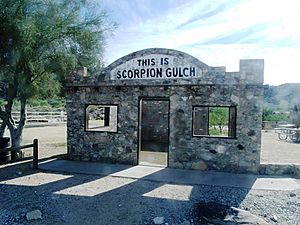Scorpion Gulch facts for kids
Scorpion Gulch is a special place located in South Mountain Park in Phoenix, Arizona. It was first built by William Lunsford as his home and a small store. Mr. Lunsford's store sold interesting items like souvenirs, crafts made by Indigenous people, and sweet treats like sodas and candy. He was still running the store in 1966 when he was 75 years old. Later, in the 1970s, the building changed and became a bar. The Phoenix Historic Property Register shows that Scorpion Gulch was built in 1936. It was officially recognized as a historic place in October 1990. Old photos show a sign on the building that said "South Mountain Trading Post," advertising jewelry, Native American crafts, and leather goods.
Contents
Meet Grandpa Bill at Scorpion Gulch
William Lunsford, the man who built Scorpion Gulch, was known by a very special name: "Grandpa." He even held a copyright for the name "Scorpion Gulch" and had it registered with the state! But he preferred to be called "Grandpa" because children were very important to him. Many kids in the neighborhood called him "Grandpa Bill."
Grandpa Bill was very kind. He didn't like to see two children sharing one soda. He thought it wasn't clean. So, he would often buy a second soda for the other child out of his own money!
He owned and ran the small store, souvenir shop, and cactus gardens near the entrance to South Mountain Park. In 1936, Mr. Lunsford bought the land. He personally carried the rocks and built the store. His living area was attached to the store, and he and his wife lived there while running the business. After his wife passed away, Bill lived there alone.
Grandpa Bill didn't make a lot of money. He often gave away sodas and was one of the few shopkeepers who still sold penny candy. He probably gave away more candy than he sold! He just couldn't help but give candy and soda to his "grandchildren" who didn't have enough money.
Because Bill wasn't always feeling well, some of the children helped him. They set up an alarm system from his place to a nearby home. This way, he could call for help if he needed it.
On a normal weekend, about 200 children would visit "Grandpa." They would enjoy his candy and soda. Parents would often call Bill to let him know a group of kids was on their way. Bill would make sure the little ones crossed the road safely to his store. When they started heading home across the mountain, Bill would call their parents. He would let them know the children were on their way home so they could watch for them.
Mr. Lunsford had many souvenirs and Native American handmade items in his shop. However, because he wasn't well, he was just selling what he had. He wasn't buying new items to restock his store.
In the cactus garden next to his shop, Bill had over 1,800 different kinds of cacti. These plants came from many different countries. Other businesses nearby also used the name "Scorpion Gulch." This was fine with Mr. Lunsford. To the many children who visited him every day, he just wanted to be known as "Grandpa." He believed a soda from "Grandpa" tasted much better than one from "Scorpion Gulch."
Scorpion Gulch Today
Today, Scorpion Gulch and the building next to it are open for everyone to visit. You can find Scorpion Gulch at 10225 S. Central Ave. It's easy to see and get to when you are driving on South Central Avenue towards South Mountain. The roofs of both buildings are mostly gone. This might be for safety reasons or because of natural wear and tear over time. Some people have heard a rumor that the building once burned down. However, there is no clear sign of fire damage on either building today.
Restoration Efforts at Scorpion Gulch
The City of Phoenix Parks and Recreation Department started important "stabilization" work on Scorpion Gulch and the nearby building in November 2012. This work was planned to finish in February 2013. During this project, the roof of the building known as "Scorpion Gulch" was removed. Also, the old wooden window frames on the different structures were replaced with new ones. This work helps to keep the historic buildings safe and standing for future visitors.
Images for kids
















